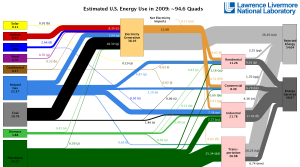In 2009, Americans burned less energy overall, but still managed to use more energy from renewable sources, according to Lawrence Livermore National Laboratory (LLNL) in California. LLNL computes and charts energy consumption annually, using data provided by the Energy Information Administration in the U.S. Department of Energy (see below).
LLNL calculates Americans in 2009 consumed 94.6 quadrillion BTUs or British Thermal Units, a standard metric of energy use, down from 99.2 quadrillion BTUs in 2008. Energy use last year declined in all four economic sectors — residential, commercial, industrial, and transportation. A.J. Simon, an energy analyst at LLNL, attributes the overall decline to economic factors, coupled with more energy-efficient vehicles and appliances.
The lab also found decreasing use in 2009 of petroleum, coal, and natural gas, even as some power plants shifted from coal to natural gas. At the same time, Americans used more renewable energy sources: wind, solar, hydro, and geothermal power. Of the renewable sources, wind power made the largest gain generating 0.71 quadrillion BTUs, up from 0.51 in 2008.
The report indicates nuclear energy use remained flat in 2009. No new plants were added or taken offline.


 RSS - Posts
RSS - Posts
I’m a student trying to learn more about the green business and I really enjoyed your article. It’s definitely worth sharing!
[…] U.S. Using More Renewables, but Less Energy Overall Share and […]
[…] Read more: U.S. Using More Renewables, but Less Energy Overall […]